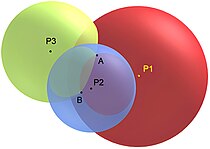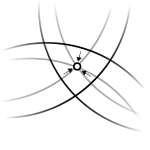Trilateration


Trilaterationis the use ofdistances(or "ranges" ) for determining the unknownposition coordinatesof apointof interest, often around Earth (geopositioning).[1] When more than three distances are involved, it may be calledmultilateration,for emphasis.
The distances or ranges might be ordinaryEuclidean distances(slant ranges) orspherical distances(scaledcentral angles), as intrue-range multilateration;or biased distances (pseudo-ranges), as inpseudo-range multilateration.
Trilateration or multilateration should not be confused withtriangulation,which usesanglesfor positioning; anddirection finding,which determines the line of sightdirectionto a target without determining theradial distance.
Terminology
[edit]Multiple, sometimes overlapping and conflicting terms are employed for similar concepts – e.g.,multilaterationwithout modification has been used for aviation systems employing both true-ranges and pseudo-ranges.[2][3]Moreover, different fields of endeavor may employ different terms. Ingeometry,trilaterationis defined as the process of determining absolute or relative locations of points by measurement of distances, using the geometry ofcircles,spheresortriangles.In surveying,trilaterationis a specific technique.[4][5][6]
True-range multilateration
[edit]True-range multilateration(also termed range-range multilateration and spherical multilateration) is a method to determine the location of a movable vehicle or stationary point in space using multipleranges(distances) between the vehicle/point and multiple spatially-separated known locations (often termed "stations" ).[7][8]Energy waves may be involved in determining range, but are not required.
True-range multilateration is both a mathematical topic and an applied technique used in several fields. A practical application involving a fixed location occurs insurveying.[9][10]Applications involving vehicle location are termednavigationwhen on-board persons/equipment are informed of its location, and are termedsurveillancewhen off-vehicle entities are informed of the vehicle's location.
Twoslant rangesfrom two known locations can be used to locate a third point in a two-dimensional Cartesian space (plane), which is a frequently applied technique (e.g., in surveying). Similarly, twospherical rangescan be used to locate a point on a sphere, which is a fundamental concept of the ancient discipline ofcelestial navigation— termed thealtitude interceptproblem. Moreover, if more than the minimum number of ranges are available, it is good practice to utilize those as well. This article addresses the general issue of position determination using multiple ranges.
Intwo-dimensional geometry,it is known that if a point lies on two circles, then the circle centers and the two radii provide sufficient information to narrow the possible locations down to two – one of which is the desired solution and the other is an ambiguous solution. Additional information often narrow the possibilities down to a unique location. In three-dimensional geometry, when it is known that a point lies on the surfaces of three spheres, then the centers of the three spheres along with their radii also provide sufficient information to narrow the possible locations down to no more than two (unless the centers lie on a straight line).
True-range multilateration can be contrasted to the more frequently encounteredpseudo-range multilateration,which employs range differences to locate a (typically, movable) point. Pseudo range multilateration is almost always implemented by measuringtimes-of-arrival(TOAs) of energy waves. True-range multilateration can also be contrasted totriangulation,which involves the measurement ofangles.Pseudo-range multilateration
[edit]Pseudo-range multilateration,often simply multilateration (MLAT) when in context, is a technique fordetermining the positionof an unknown point, such as a vehicle, based on measurement of thetimes of arrival(TOAs) of energy waves traveling between the unknown point and multiple stations at known locations. When the waves are transmitted by the vehicle, MLAT is used forsurveillance;when the waves are transmitted by the stations, MLAT is used fornavigation(hyperbolic navigation). In either case, the stations' clocks are assumed synchronized but the vehicle's clock is not.
Prior to computing a solution, the commontime of transmission(TOT) of the waves is unknown to the receiver(s), either on the vehicle (one receiver, navigation) or at the stations (multiple receivers, surveillance). Consequently, also unknown is the wavetimes of flight(TOFs) – the ranges of the vehicle from the stations divided by the wave propagation speed. Eachpseudo-rangeis the corresponding TOA multiplied by the propagation speed with the same arbitrary constant added (representing the unknown TOT).
In navigation applications, the vehicle is often termed the "user"; in surveillance applications, the vehicle may be termed the "target". For a mathematically exact solution, the ranges must not change during the period the signals are received (between first and last to arrive at a receiver). Thus, for navigation, an exact solution requires a stationary vehicle; however, multilateration is often applied to the navigation of moving vehicles whose speed is much less than the wave propagation speed.
Ifis the number of physical dimensions being considered (thus, vehicle coordinates sought) andis the number of signals received (thus, TOAs measured), it is required that.Then, the fundamental set ofmeasurement equations is:
- TOAs (measurements) = TOFs (unknown variables embedded inexpressions) + TOT (one unknown variable replicatedtimes).
Processing is usually required to extract the TOAs or their differences from the received signals, and analgorithmis usually required to solve this set of equations. An algorithm either: (a) determines numerical values for the TOT (for the receiver(s) clock) andvehicle coordinates; or (b) ignores the TOT and forms(at least)time difference of arrivals(TDOAs), which are used to find thevehicle coordinates. Almost always,(e.g., a plane or the surface of a sphere) or(e.g., the real physical world). Systems that form TDOAs are also calledhyperbolicsystems,[11]for reasons discussed below.
A multilaterationnavigationsystem provides vehicle position information to an entity "on" the vehicle (e.g., aircraft pilot or GPS receiver operator). A multilaterationsurveillancesystem provides vehicle position to an entity "not on" the vehicle (e.g., air traffic controller or cell phone provider). By the reciprocity principle, any method that can be used for navigation can also be used for surveillance, and vice versa (the same information is involved).
Systems have been developed for both TOT and TDOA (which ignore TOT) algorithms. In this article, TDOA algorithms are addressed first, as they were implemented first. Due to the technology available at the time, TDOA systems often determined a vehicle location in two dimensions. TOT systems are addressed second. They were implemented, roughly, post-1975 and usually involve satellites. Due to technology advances, TOT algorithms generally determine a user/vehicle location in three dimensions. However, conceptually, TDOA or TOT algorithms are not linked to the number of dimensions involved.References
[edit]- ^Engineers, A.S.C. (1994).Glossary of the Mapping Sciences.American Society of Civil Engineers. p. 548.ISBN978-0-7844-7570-6.Retrieved2022-11-07.
- ^"Multilateration (MLAT) Concept of use", International Civil Aviation Organization, 2007
- ^"Radar Basics",Christian Wolff, undated
- ^Encyclopædia Britannica
- ^diracdeltaArchived2010-08-12 at theWayback Machine
- ^free dictionary
- ^Accuracy limitations of range-range (spherical) multilateration systems,Harry B. Lee, Massachusetts Institute of Technology, Lincoln Laboratory, Report Number: DOT/TSC-RA-3-8-(1) (Technical note 1973-43), Oct. 11, 1973
- ^"Rho-Rho Loran-C Combined with Satellite Navigation for Offshore Surveys".S.T. Grant,International Hydrographic Review,undated
- ^Wirtanen, Theodore H. (1969). "Laser Multilateration".Journal of the Surveying and Mapping Division.95(1). American Society of Civil Engineers (ASCE): 81–92.doi:10.1061/jsueax.0000322.ISSN0569-8073.
- ^Escobal, P. R.; Fliegel, H. F.; Jaffe, R. M.; Muller, P. M.; Ong, K. M.; Vonroos, O. H. (2013-08-07)."A 3-D Multilateration: A Precision Geodetic Measurement System".JPL Quart. Tech. Rev.2(3).Retrieved2022-11-06.
- ^Proc, Jerry (2021)."Hyperbolic Radionavigation Systems".RetrievedApril 11,2022.






